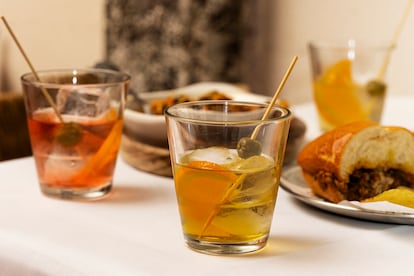In Barcelona they say for the vermouth or whatever is the same as vermouth time in the rest of Spain. Catalans usually have their trusted vermouth shop, they stop, grab a vermouth, a tapa, have a chat and continue on their way. This ritual is slow to arrive in Mexico City, where time is running out and breaks are avoided, which sometimes turn into eternal after-dinner moments. Furthermore, many still think that vermouth is only used to prepare classic cocktails – negronis or martinis – even though it is an excellent drink on its own.
“When we opened, people always asked us what vermouth was,” says Bógar Adame Mendoza, co-founder of Oropel, a vermouth shop located in Roma Norte. After three years, this picturesque cave has around 70 bottles of vermouth and is an unmissable place for lovers of this drink or for those who want to know more.
The answer is that vermouth is a wine fortified with a spirit infused with herbs, spices, or even fruit. There are commercial brands and many homemade because you can make it at home, which is why it is so diverse. The only rule is to prepare it with absinthe, the obligatory ingredient from which it takes its name. Absinthe is pronounced in German Wermut and according to historical accounts it was the Germans who began infusing it into wines for medicinal purposes, although it was the Italians who popularized it.
Bógar became passionate about vermouth after entering the world of natural wines and was surprised by its range of flavours: “There are sweet ones, semi-dry ones, dry ones, balanced ones, acidic ones… everything, it’s more about finding the right profile for you,” he says. His advice is to taste it without fear of getting drunk because vermouths have a low alcohol content and are served in small glasses over ice, usually with a slice of orange or an olive (or both).
The most popular and well-known vermouths in Mexico are Spanish and red; Those of the Italian commercial brands have been part of our canteens for many years, such as Cinzano or Martini, and the French ones are slowly making their appearance. Vermouth is generally classified as dry or sweet, a correspondence that is usually associated with the colour: white-dry and red-sweet. This generalization remains unsupported in the face of the inventiveness and taste of each vermouth producer. This is the most beautiful quality of vermouth: it is local and sometimes unparalleled. According to Bogar, “growers generally use herbs they find around their field.” So the flavor responds to whoever makes it, so the first step to falling in love with this drink is to find one you like and keep exploring, or stick with your favorite.
Without a designation of origin to tie our hands, there are already people in Mexico who have started producing it and, as Bógar says, they deserve more recognition: “I want more light to be given to Mexican vermouth. I have great friends who produce vermouth and who should be there reflector. Plus we have a lot of amazing herbs, why not take advantage of them?”
In Baja California, where the most important wine-growing area of the country is located, several years ago Daniela D’Acosta created Salsitrabajos, Silvana Pijoan created Vermut Negro Pijoan and Oscar Mancillas created Vermut Radicante. Back in Mexico City, Carlos Pellicer founded Siempre Vermut during the pandemic confinement. All these brands are on sale in some bars, restaurants or wine shops.

Nicolás Martín del Campo joins this list with the vermouths he made exclusively for La barra de al lado, a liquor store and cannery founded at the end of 2023 with his sister, chef Lula Martín del Campo. “My and Lula’s goal was to create a neighborhood bar, so that our prices are accessible and gastronomy must be democratized,” says Nico. Their vermouth costs 95 pesos and has four options: the white is fresh and balanced, the rosé tastes like currants, the orange has a subtle hint of apricot, and the red is more caramelized. The latter is Nico’s favourite: “I really like it. The characteristic is that it is very Christmassy, very spicy. It has ginger, cardamom, star anise, cinnamon… I make the first three with white wine (white, rosé and orange), and the red one with red wine”.
If the base is wine, producers also play with the distillate used to fortify vermouth, the most common is grape brandy, others use gin, vodka or sherry. Nico opted for vodka and combined it with various ingredients until he was able to give his vermouths the desired color and flavor. She recommends starting with white or pink on warm days, “or moving straight to red, especially now in this cold weather.” In addition to stocking the shelves of his liquor store with dozens of bottles of vermouth, wines and imported spirits like tequila or mix, he also chooses Portuguese and Spanish canned preserves that complement the experience and the music that blares from the speakers.

For Nico the most important thing is “to make known the idea of the aperitif, how good it is to come and have a snack and a vermouth and, above all, to create a neighbourhood”. In an effervescent city like this, bars perform the function of bringing people together, preferably if they are neighbors. This is the essence of vermutería, an invitation to stop and socialize.
Together with Oropel and La barra de al lado, he opened Carmel, founded by the Catalan Guillem Iñiguez, so nostalgic for his neighborhood in Barcelona that he decided to call his vermouth bar that way and developed the Vermut de Casa brand, which he produces in Santa María La Ribera with local ingredients. Likewise, on the menus of numerous restaurants – especially Spanish ones such as La Cocina del Bizco, specializing in Spanish labels – and bars in the capital, this drink already appears as an option. The slow arrival of the vermouth makes sense with the pause, there is no need to press the accelerator, little by little (little by little in Catalan) Mexicans will surrender to the parsimony of a small glass of vermouth.



